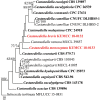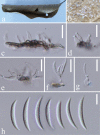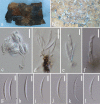The genus Castanediella
- PMID: 31048984
- PMCID: PMC6477871
- DOI: 10.3897/mycokeys.51.32272
The genus Castanediella
Abstract
Two new species, Castanediellabrevis and C.monoseptata, are described, illustrated and compared with other Castanediella taxa. Evidence for the new species is provided by morphological comparison and sequence data analyses. Castanediellabrevis can be distinguished from other Castanediella species by the short hyaline conidiophores and fusiform, aseptate hyaline conidia, while C.monoseptata differs from other Castanediella species by its unbranched conidiophores and fusiform, curved, 0-1-sepatate, hyaline conidia. Phylogenetic analysis of combined ITS and LSU sequence data was carried out to determine the phylogenetic placement of the species. A synopsis of hitherto described Castanediella species is provided. In addition, Castanediella is also compared with morphologically similar-looking genera such as Idriella, Idriellopsis, Microdochium, Neoidriella, Paraidriella and Selenodriella.
Keywords: Castanediellaceae; Sordariomycetes; hyphomycetes; new taxa; phylogeny.
Figures



References
-
- Altschul SF, Gish W, Miller W, Myers EW, Lipman DJ. (1990) Basic local alignment search tool. Journal of Molecular Biology 215: 403–410. - PubMed
-
- Castañeda Ruiz RF, Heredia GP, Arias RM, Stadler M, Minter DW. (2005) Two Hyphomycetes from submerged plant material of México. Mycotaxon 91: 333–338.
-
- Chomnunti P, Hongsanan S, Aguirre-Hudson B, Tian Q, Persoh D, Dhami MK, Alias AS, Xu J, Liu X, Stadler M, Hyde KD. (2014) The sooty moulds. Fungal Diversity 66: 1–36. 10.1007/s13225-014-0278-5 - DOI
-
- Costa PM, Barbosa MA, Da Silva GV, Sosa D, Pérez-Martinez S, Castañeda-Ruiz RF, Malosso E. (2018) Castanedielladiversispora sp. nov. from the Brazilian Atlantic Forest. Mycotaxon 133: 63–69.
-
- Crous PW, Wingfield MJ, Burgess TI, Hardy GESJ, Crane C, Barrett S, Cano-Lira JF, Leroux JJ, Thangavel R, Guarro J, Stchigel AM, Martín MP, Alfredo DS, Barber PA, Barreto RW, Baseia IG, Cano-Canals J, Cheewangkoon R, Ferreira RJ, Gené J, Lechat C, Moreno G, Roets F, Shivas RG, Sousa JO, Tan YP, Wiederhold NP, Abell SE, Accioly T, Albizu JL, Alves JL, Antoniolli ZI, Aplin N, Araújo J, Arzanlou M, Bezerra JDP, Bouchara JP, Carlavilla JR, Castillo A, Castroagudín VL, Ceresini PC, Claridge GF, Coelho G, Coimbra VRM, Costa LA, da Cunha KC, da silva SS, Daniel R, de beer ZW, Dueñas M, Edwards J, Enwistle P, Fiuza PO, Fournier J, García D, Gibertoni TB, Giraud S, Guevara-Suarez M, Gusmão LFP, Haituk S, Heykoop M, Hirooka Y, Hofmann TA, Houbraken J, Hughes DP, Kautmanová I, Koppel O, Koukol O, Larsson E, Latha KPD, Lee DH, Lisboa DO, Lisboa WS, López-Villalba Á, Maciel JLN, Manimohan P, Manjón JL, Marincowitz S, Marney TS, Meijer M, Miller AN, Olariaga I, Paiva LM, Piepenbring M, Poveda-Molero JC, Raj KNA, Raja HA, Rougeron A, Salcedo I, Samadi R, Santos TAB, Scarlett K, Seifert KA, Shuttleworth LA, Silva GA, Silva M, Siqueira JPZ, Souza-Motta CM, Stephenson SL. (2016a) Fungal Planet description sheets: 469–557. Persoonia - Molecular Phylogeny and Evolution of Fungi 37: 218–403. - PMC - PubMed
LinkOut - more resources
Full Text Sources
